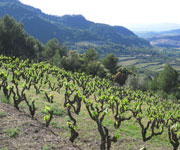The entire landscape of the Tokaji wine region, including both vineyards and long established settlements, vividly illustrates a specialized form of traditional land use and represents a distinct viticultural tradition that has existed for at least 1,000 years and which has survived intact to the present day. The Magyar tribes who entered the area at the end of the 9th century assigned special significance to the region, as they believed (with some justification) that it was the centre of the empire of Attila the Hun, with whom they closely identified themselves. It became a protected refuge for Hungarians in the centuries that followed in the face of pressure from invading Mongols and others, as well as an important commercial crossroads for Polish merchants travelling to the Balkans and elsewhere.

Continent: Europe
Country: Hungary
Category: Cultural
Criterion: (III)(V)
Date of Inscription: 2002
Tokaj Wine Region's 12th Centaury
Settlers were welcomed from as early as the 12th century, when Walloon and Italian immigrants were invited in, joining the Germans who had been there since the beginning of the Hungarian kingdom. In the 16th century the region came under Bohemian Hussite domination for a while, but was reunited with the Hungarian kingdom by the last great Hungarian king, Hunyadi Matyas (Matthias Corvinus). It was during the Ottoman period that the Tokaji Aszu for which the region became world famous was first produced. Legend has it that fears of Turkish raiders delayed the harvest in Lorantffy Mihaly's domain until the grapes had shrivelled and Botrytis infection had set in, creating the 'noble rot' (pourriture noble ). Nonetheless, the pastor Szepsi Laczko Mate made wine from them, presenting the result to the daughter of the overlord.The mild climate makes coupled with the soil quality and aspects of the slopes make Tokaj perfect for cultivating grapes. The settlement system and forms of the Tokaji Wine Region are dictated by the morphological and hydrographic features of the area. There are two main axes of settlement, one the river Bodrog and the other the Szerencs stream and the river Hernád at the western edge. There is a chain of settlements along the right bank of the Bodrog as it meanders at the foot of the Zemplen mountain range.
 |
| Tokaj Wine Region Historic Cultural Landscape Hungary |
Browse Gallery Plus UNESCO Storyline
Other settlements are to be found in the valleys of the streams that feed into the Bodrog, which in its turn joins the Tisza at Tokaj, an ancient crossing point of the main river. The Szerencs opens wide into the Takta and has settlements on both banks. The name 'Tokaj' is derived from an Armenian word for grape that came into the Hungarian language as early as the 10th century, thus giving a date for the creation of the settlement. It is also evidence that viticulture was already being practised here at that time.
The built heritage of the region is symbolic of its history and its socio-economic structure. There are to be found medieval Roman Catholic churches (one in each settlement), 18th- to 19th-century Orthodox churches, and Jewish synagogues, princely and aristocratic castles and mansions, and more humble houses, wine stores, and workshops. Evidence of early settlement is the 12th century Romanesque church at Bodrogalszi (in the buffer zone). There are ruined 14th-century castles at Tokaj and Tallya in the nominated area and Monok, Sarospatak, and Szerencs in the buffer zone. Noble mansions from the 18th and 19th centuries are to be found at Tarcal and in the buffer zone.
The most characteristic structures in Tokaj are the wine cellars: that of King Kalman in Tarcal is known to have been in existence as early as 1110. There are two basic types of cellar in Tokaj: the vaulted and the excavated. The former was essentially an open space below a residential building, excavated before the house was built and accessed from the porch. The grapes were processed in a room at the rear of the house, immediately above the cellar. The excavated cellars were not connected directly with the residential buildings. All that is visible on the surface is a stone entrance structure with a latticed wooden or steel gate. Cellars carved into the volcanic tuff did not require reinforcement by vaulting. Some 80-85% of the cellars in Tokaj were made in this way.
Of special interest are the multi-level labyrinthine cellars with unsystematic floors plans in which wine was stored and matured in casks made from sessile oak. The most famous is the cellar network in the Ungvari district of Satoraljaujhely, the result of interconnecting no fewer than 27 cellars at different levels.
Browse All UNESCO World Heritage Sites in
Hungary. The original UNESCO inscription
Here!!!











No comments:
Post a Comment